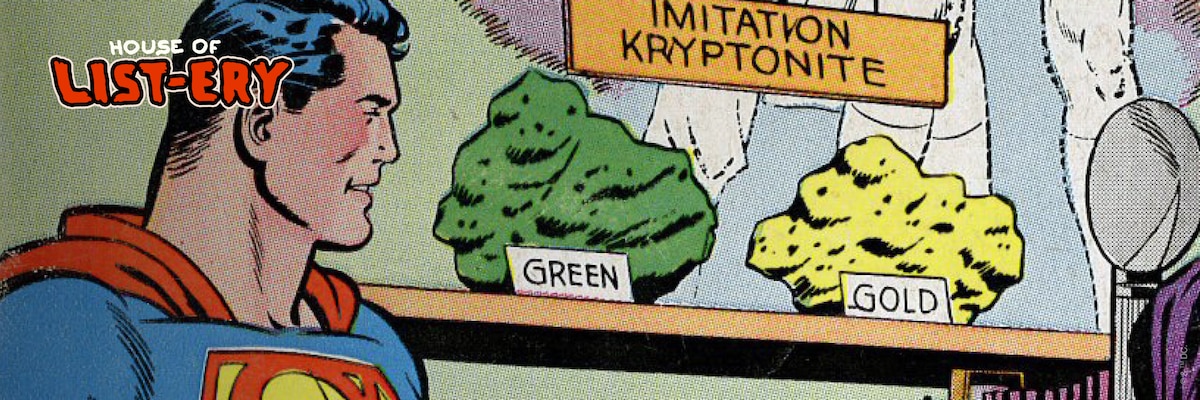As much as he’s revered as a champion of truth and justice, Superman is just as renowned for his nearly flawless invulnerability. While a formidable foe to almost anyone, the canny villain knows there are a few tricks around his defenses: the irradiated remains of his home planet Krypton, scattered across the universe as multicolored, multifaceted Kryptonite. The most common form of Kryptonite’s effect is easy to anticipate: it weakens and eventually kills Superman. But if the space rock in your hand isn’t green, you may find it carries a different effect entirely. With DC Black Label’s upcoming Superman: The Kryptonite Spectrum exploring bold new variants we’ve never seen before, now is a great time to go over the varieties we know so far.
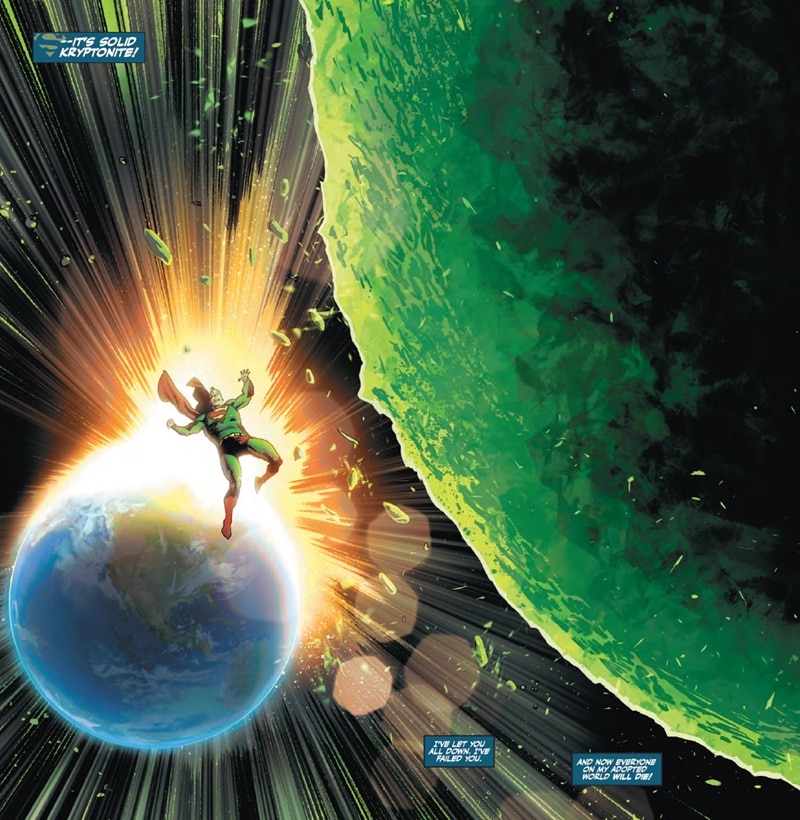
Green Kryptonite
First Discovered: Disputed
Like many of the great storied concepts in comic book lore, the standard issue “green” kryptonite, as we know it today, evolved in stages. Jerry Siegel and Joe Shuster’s first attempted to introduce Kryptonite as the “K-Metal” from Krypton in a 1940 script that went unpublished for over sixty years. (The reason: at the end, Superman reveals his identity to Lois Lane, establishing a new status quo. Editorial determined that the public wasn’t quite ready for that yet.)
People would first get to know Kryptonite through the popular Adventures of Superman radio serial, in the 1943 episode, “The Meteor from Krypton.” Six years later, Kryptonite—first colored red, though recolored green in some reprints—would make its debut on the comics page in Superman #61.
For the next two years, the color of Kryptonite as it appeared in the comics would be inconsistent—sometimes red, sometimes even purple. The green would be codified by 1951’s Action Comics #161, setting the control against which all future variants of Kryptonite might be measured.
We all know what green Kryptonite does. It’s Superman’s most legendary weakness, sapping the potency of a yellow sun-empowered Kryptonian’s abilities in proximity to the mineral, with prolonged exposure resulting in death
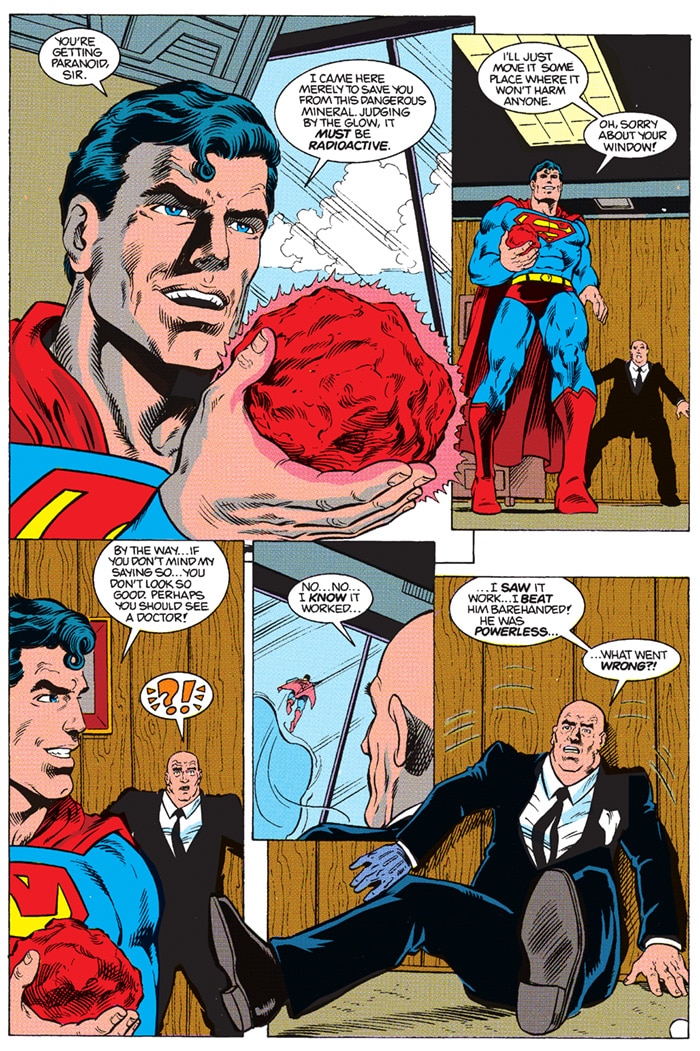
Red Kryptonite
First Discovered: Adventure Comics #255 (1958)
Red kryptonite, once it was differentiated from the green kind, is your wild card. The “fun” kryptonite. Often, the backbone of your typical Silver Age Superman story. Where green Kryptonite weakens a Kryptonian, every fragment of red Kryptonite has a completely unpredictable effect, usually wearing off after 24 or 48 hours. The most common red Kryptonite effect, as seen on television, or as recently as this month’s Superman #26, is a flaring temper and an erosion of inhibitions. But red Kryptonite can also turn Kryptonians into giants, or give them insectoid heads, or uncontrollable beard growth.
In Batman/Superman: World’s Finest #12, Supergirl briefly mentions the existence of Bizarro Red Kryptonite, which carries the same randomized, unpredictable effects, but on humans instead of Kryptonians.
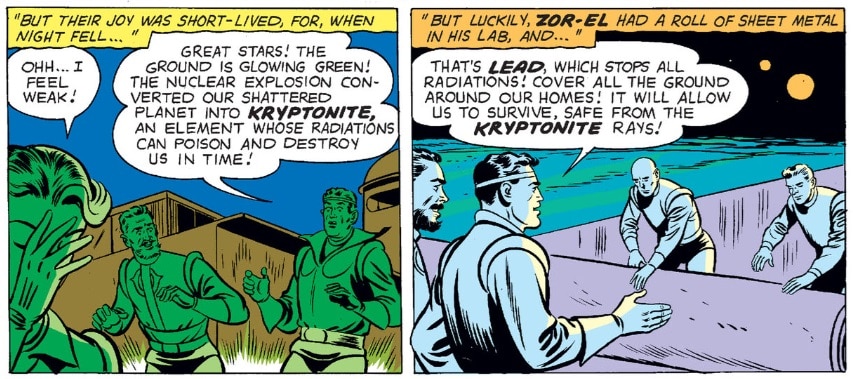
Anti-Kryptonite
First Discovered: Action Comics #252 (1959)
Anti-Kryptonite carries the same effects as green Kryptonite, but not for empowered Kryptonians. This variety is known to affect Kryptonians unexposed to yellow solar energy, first introduced in the downfall of the Argo City colony from which Supergirl was originally the sole survivor.
X-Kryptonite
First Discovered: Action Comics #261 (1960)
Sometimes called “Orange Kryptonite,” X-Kryptonite was originally an invention of Supergirl, whose experimentation gifted Streaky the Supercat with his powers. Most consistently, orange Kryptonite has the ability to grant powers to animals, as seen in the DC League of Super Pets movie. In the Superman & Lois television series, X-Kryptonite can also bestow Kryptonian powers to humans for a limited time.
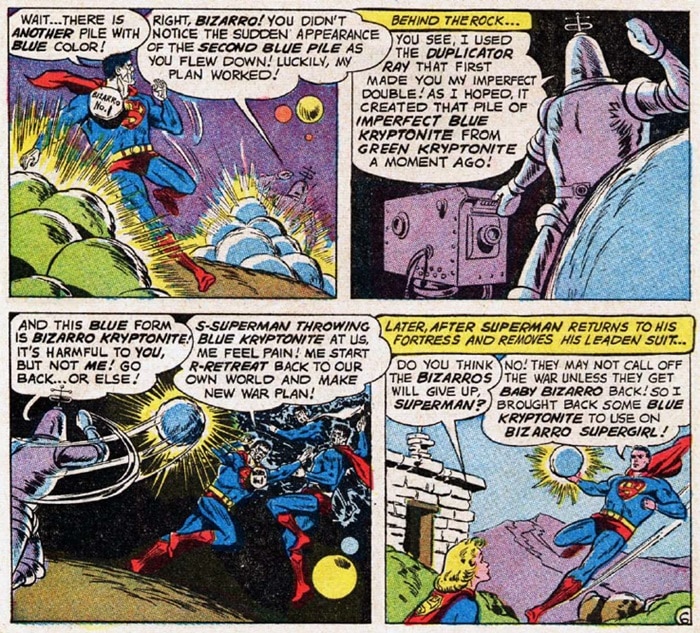
Blue Kryptonite
First Discovered: Superman #140 (1960)
Typically, blue Kryptonite, first created through use of the Bizarro duplicator ray on green Kryptonite, has the power to affect Bizarro clones in the same way that green Kryptonite affects Superman. But like many of the more obscure colored Kryptonite variants, the details have changed over time. In the Post-Crisis period, blue Kryptonite made Bizarro clones intelligent. Grant Morrison’s Action Comics run proposed that blue Kryptonite was harmful to the Kryptonian soul. And on the Super Friends animated series, blue Kryptonite could be used as a quick antidote to the effects of red Kryptonite.
White Kryptonite
First Discovered: Adventure Comics #279 (1960)
Technically one of the most universally effective forms of Kryptonite, white Kryptonite is lethal to plants, bacteria and viruses from any world.
Red-Green Kryptonite
First Discovered: Action Comics #275 (1961)
A variant used only once by Brainiac which caused Superman to grow a third eye on the back of his head. Functionally just another variant of red Kryptonite.
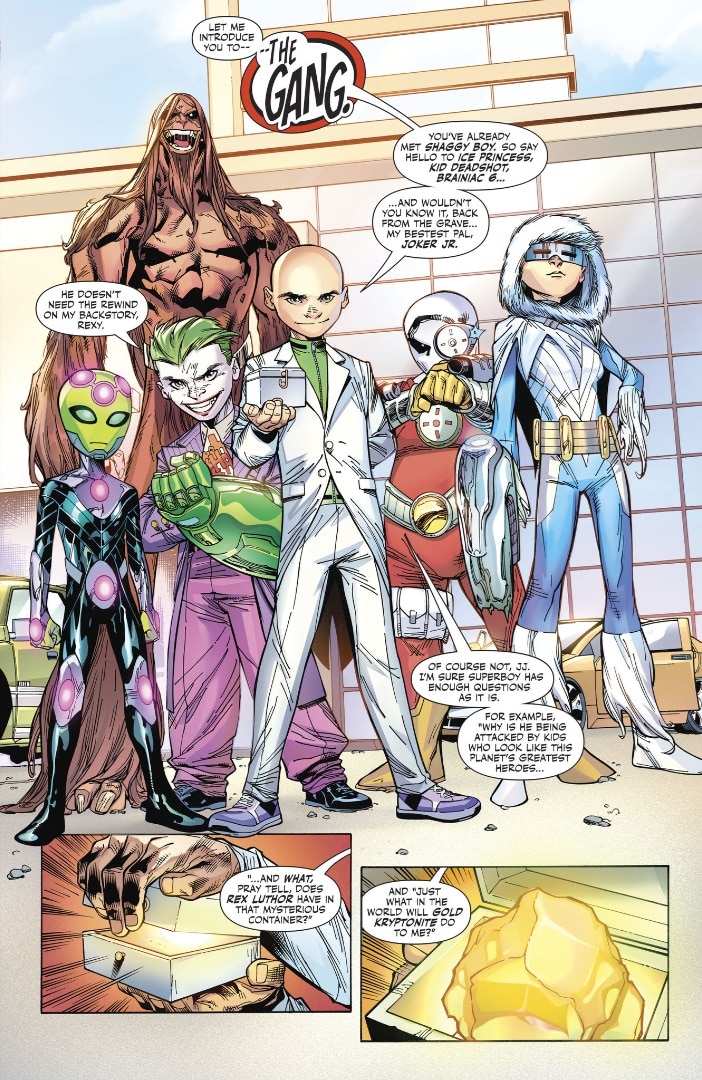
Gold Kryptonite
First Discovered: Adventure Comics #299 (1962)
One of the most infamous forms of Kryptonite, the gold variety can permanently strip any Kryptonian of their ability to process yellow solar radiation, rendering them powerless. In the animated series Justice League Action, gold Kryptonite merely causes amnesia.
Red-Green-Blue-Gold Kryptonite
First Discovered: Superman #162 (1963)
This alloy of the four most well-known forms of Kryptonite at the time was used once in an “Imaginary Story” to split Superman into two entities, “Superman Red” and “Superman Blue.” This concept of dual, color-themed Supermen would be revisited in the decades to come, via other circumstances.

Jewel Kryptonite
First Discovered: Action Comics #310 (1964)
Formed from the former Jewel Mountains of Krypton, jewel Kryptonite has the ability to bestow telepathic abilities within the confines of the Phantom Zone—allowing Kryptonians inside it to mentally reach out to the material plane. In 2000’s Silver Age event, it was believed that combining jewel Kryptonite with the Green Lantern power battery would remove its weakness to the color yellow.
Red-Gold Kryptonite
First Discovered: Superman #178 (1965)
This alloy bestows Kryptonians with temporary amnesia, but otherwise has no effect on a Kryptonian’s powers.
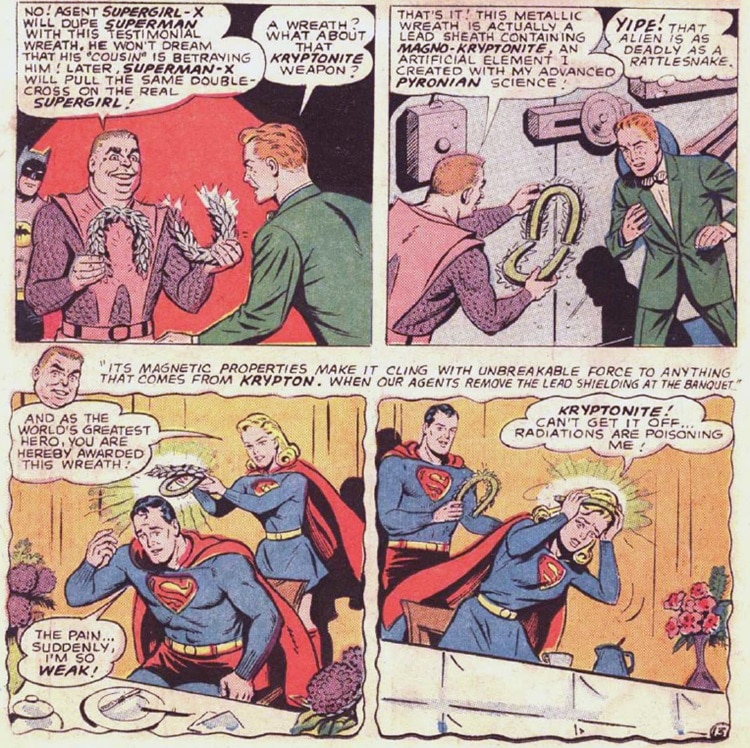
Magno-Kryptonite
First Discovered: Superman’s Pal, Jimmy Olsen #92 (1966)
One of the more useful forms of Kryptonite, this variant is powerfully attracted to anything from the planet Krypton, functioning as a very practical tracking device.
Krypton Steel
First Discovered: Challenge of the Super Friends, “Rest in Peace” (1973)
Lex Luthor describes this variant as a “harmless form of Kryptonite” which is most useful as an extremely durable building material. Only a Kryptonian has the power to break it.
Slow Kryptonite
First Discovered: The Brave and the Bold #175 (1981)
Named for its “slow frequency” compared to the more rapid green Kryptonite, this variant was modified from green Kryptonite by Metallo to affect humans as green Kryptonite does to Kryptonians.

Kryptonite-X
First Discovered: Adventures of Superman #511 (1994)
Discovered and named by Professor Emil Hamilton, Kryptonite-X was originally formed from standard green Kryptonite during a battle between Cyborg Superman and the Eradicator. This variant can restore a depleted Kryptonian’s powers…to a fault. The build-up of power from exposure to Kryptonite-X causes a Kryptonian to increase in size and lose control of their abilities altogether.
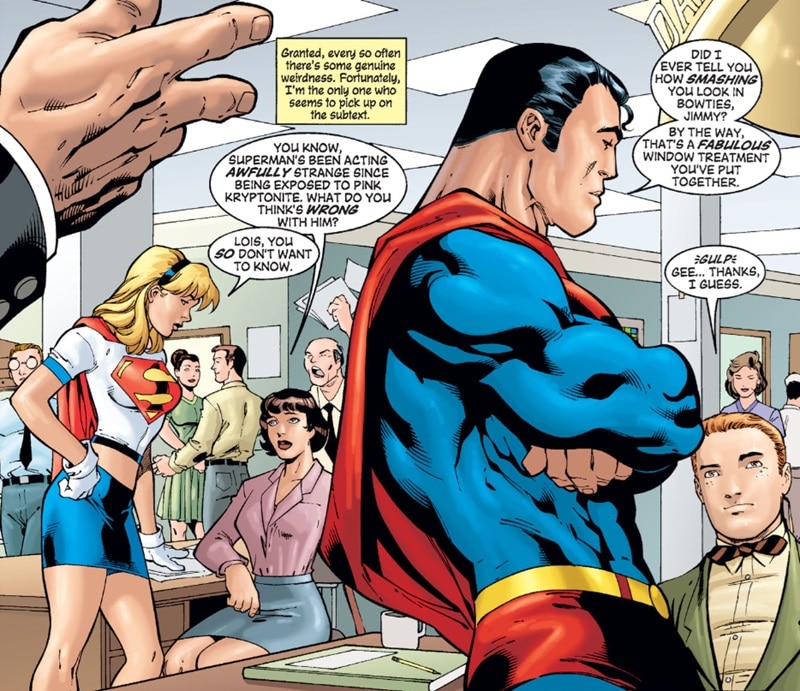
Pink Kryptonite
First Discovered: Supergirl #79 (2003)
The fans love to talk about this one. Pink Kryptonite originally appeared in just one panel of Peter David’s Supergirl comic as a throwaway gag. The context, which we shall leave here to the reader, has driven speculation for over twenty years. In Justice League Action, exposure to pink Kryptonite temporarily transformed Superman into Superwoman.
Black Kryptonite
First Discovered: Smallville, “Crusade” (2004)
Black Kryptonite arguably draws its origins from 1983’s Superman III, when Gus Gorman substituted tar for a crucial ingredient in a synthetic Kryptonite variant. The resulting “tar Kryptonite” temporarily changed Superman into a chaotic, evil entity, and eventually split him into two bodies as Superman and Clark Kent. More than twenty years later, on TV’s Smallville, black Kryptonite was introduced to nearly the same effect. Since then, black Kryptonite has gone on to appear in comics from All-Star Superman to The Batman Who Laughs as a variant which can corrupt the morality of the Man of Steel, driving him anywhere from merely selfish behavior to uncontrollably violent.
Purple Spotted Kryptonite
First Discovered: Krypto the Superdog, “Streaky’s Supercat Tale” (2005)
One of the best variants of Kryptonite ever created, purple spotted Kryptonite’s only documented effect is instilling Kryptonian canines with the uncontrollable urge to chase their own tails.
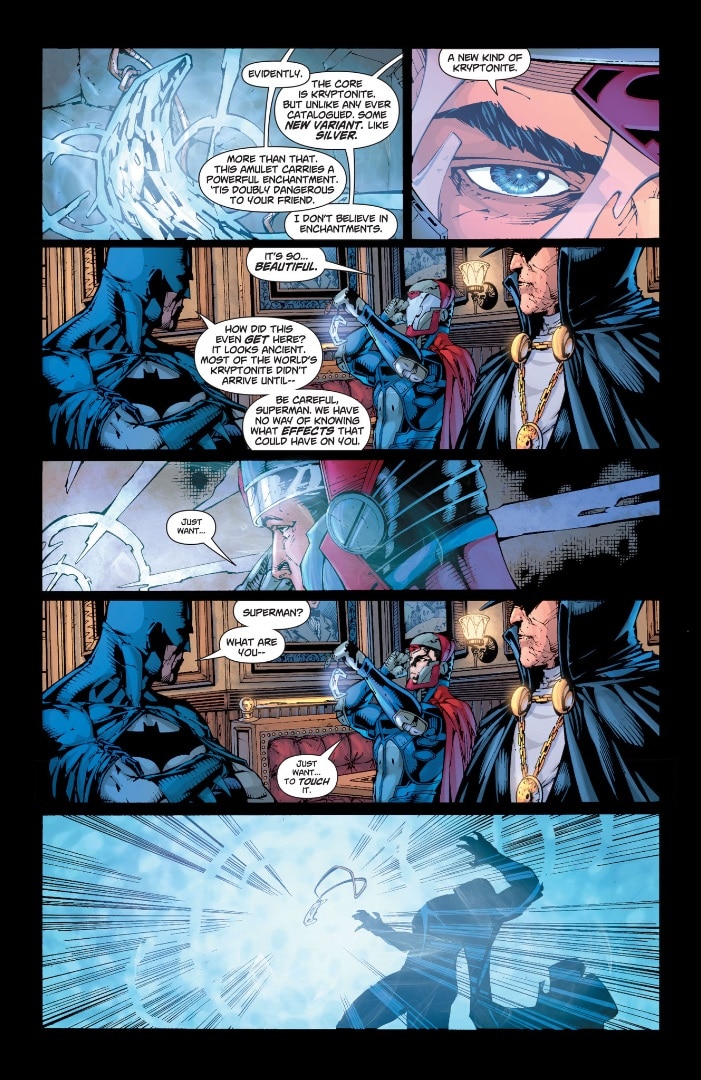
Silver Kryptonite
First Discovered: Smallville, “Splinter” (2005)
Silver Kryptonite originally appeared as a hoax in 1963’s Superman’s Pal, Jimmy Olsen #70. More than forty years later, it would be reintroduced on TV’s Smallville as a creation of Dr. Milton Fine that induces hallucinatory effects in Kryptonians. This variant would make its way to the comics in 2008’s Superman/Batman #46, where in addition to its perceptive-altering features, it was said to also contain magical properties.
Opal Kryptonite
First Discovered: Earth 2 #0 (2012)
A variant created by Terry Sloane of the Post-Flashpoint Earth 2, with the property to induce temporary insanity in Kryptonians.
Periwinkle Kryptonite
First Discovered: Superman Family Adventures #9 (2013)
Exposure to periwinkle Kryptonite in the young reader Superman Family Adventures series bestows a Kryptonian with—and I’m afraid there’s no other way to put this—rizz. In the DC Super Hero Girls TV series, it merely drives a Kryptonian into an uncontrollable bout of giggling.
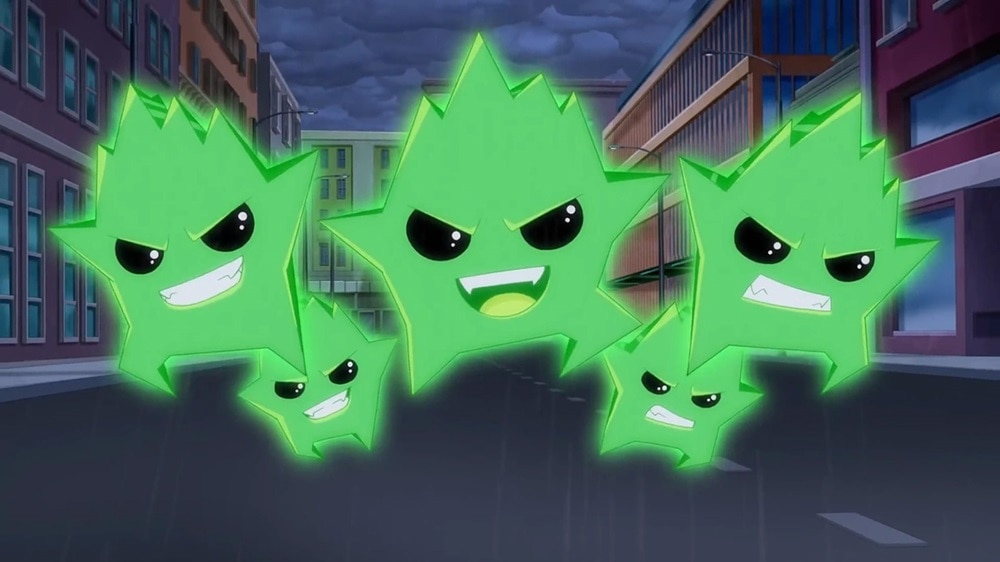
Kryptomites
First Discovered: DC Super Hero Girls, “Tales from the Kryptomites” (2017)
All kinds of villains, from Lex Luthor to Gorilla Grodd, have been successful to varying degrees in creating their own synthetic Kryptonite. But perhaps none have been so creative as Lena Luthor in the DC Super Hero Girls webseries, whose “Kryptomites” are sentient, crystalline creatures that wreak havoc on Metropolis. Green Kryptomites have a predictable effect. But red and yellow variants can induce rage and fear in non-Kryptonians (respectively), while Lena employs purple Kryptomites for mind control.
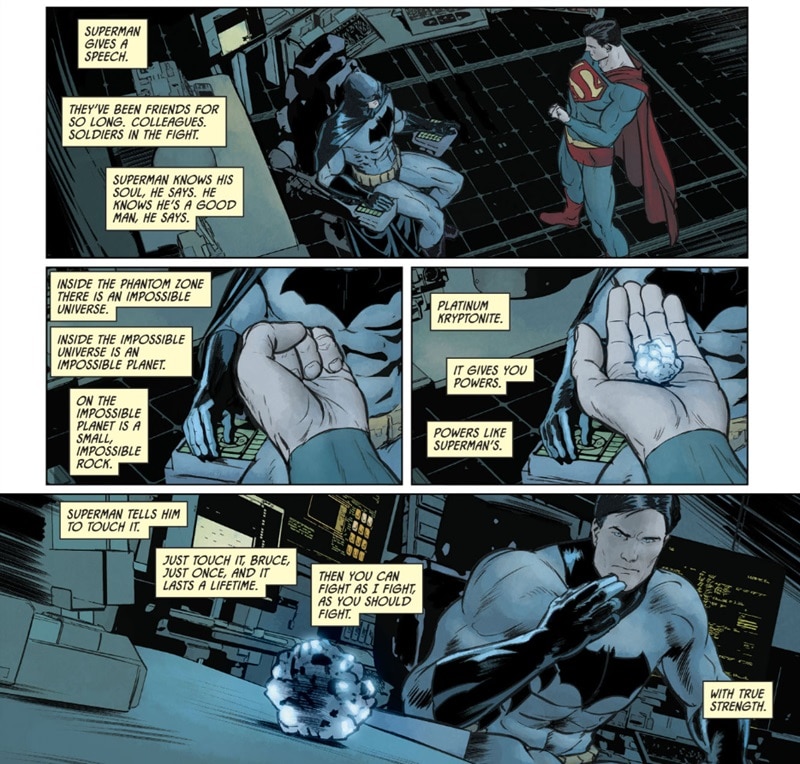
Platinum Kryptonite
First Discovered: Batman Secret Files #1 (2018)
Essentially the opposite of gold Kryptonite, the platinum variant can be used to bestow any non-Kryptonian with permanent Kryptonian powers. Superman gifts the only known sample of platinum Kryptonite to Batman, who declines to use it on himself—instead using it on Claire Clover, known to the citizens of Gotham City as Gotham Girl.
Amber Kryptonite
First Discovered: Dark Nights: Death Metal: The Last 52: War of the Multiverses (2020)
Somewhere in the Dark Multiverse, this Kryptonite variant carries the properties of both gold and platinum Kryptonite—functionally siphoning the powers of a Kryptonian to a non-Kryptonian.
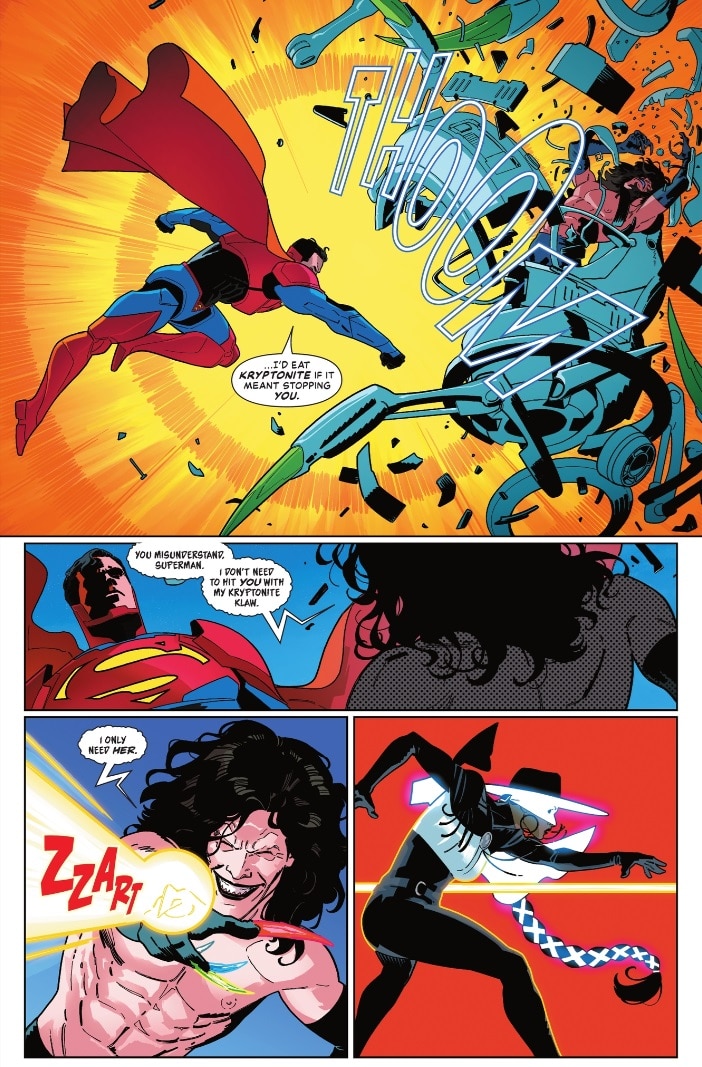
Yellow Kryptonite
First Discovered: Superman #9 (2023)
Finally, at least for now, is the long unknown mystery of yellow Kryptonite. First appearing as a hoax variant by Lex Luthor in 1961’s Action Comics #277, this variant in subsequent appearances was long considered either fictitious or carrying an effect yet to be determined. After more than sixty years, yellow Kryptonite was finally, successfully deployed by Luthor’s rival Dr. Pharm in the current ongoing Superman run, as exposure to yellow Kryptonite launched Superman and Marilyn Moonlight over a century into the past.
For all our research, all indication is that our findings here are merely the tip of the crystalline fortress. For more yet unknown new forms of Kryptonite, set your signal watches to August 13th for Superman: The Kryptonite Spectrum.
Superman finds himself living in a world of Kryptonite in Dan Slott and Rafael Albuquerque’s Superman Unlimited #1, in stores now! And don’t miss Superman: The Kryptonite Spectrum by W. Maxwell Prince, Martín Morazzo and Chris O’Halloran, available everywhere August 13, 2025!
Alex Jaffe is the author of our monthly "Ask the Question" column and writes about TV, movies, comics and superhero history for DC.com. Follow him on Bluesky at @AlexJaffe and find him in the DC Official Discord server as HubCityQuestion.
NOTE: The views and opinions expressed in this feature are solely those of Alex Jaffe and do not necessarily reflect those of DC or Warner Bros. Discovery, nor should they be read as confirmation or denial of future DC plans.
